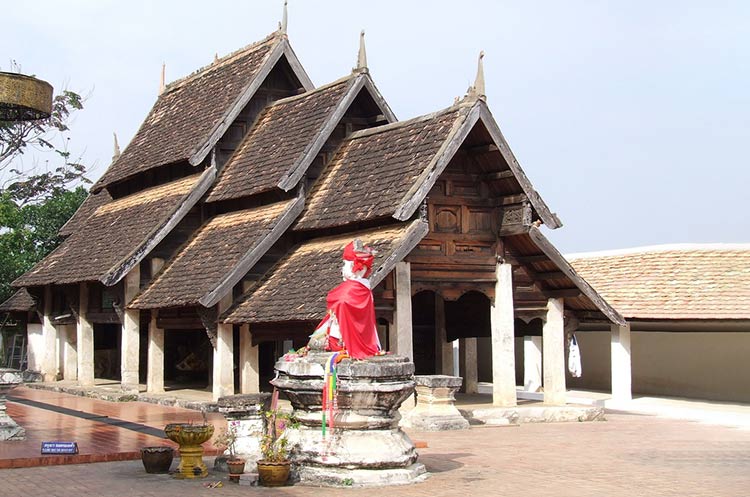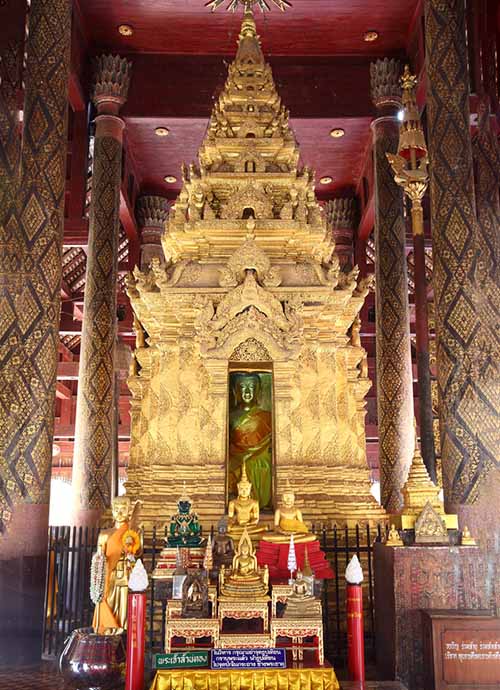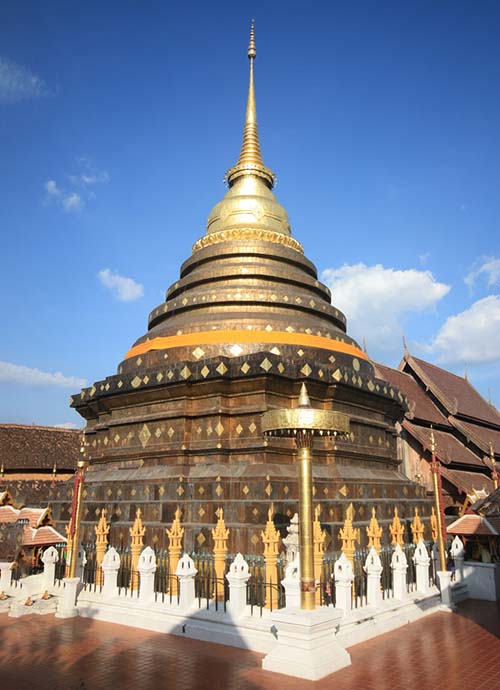
Wat Phra That Lampang Luang
Fine example of Lanna architecture
Lampang
The Wat Phra That Lampang Luang is one of the most highly revered temples in Thailand. According to legend the Buddha once visited the site some 2,500 years ago and donated a hair, which is now enshrined in the temple’s large chedi.
Lanna architecture
The temple is one of the best examples of Lanna style architecture in Thailand. Its viharns that are open on all sides are typical of the early Lanna style. Whereas some temples have been restored using modern materials and modern building techniques, the Wat Phra That Lampang Luang has been preserved in its original state.
The temple was founded in the 13th century. Its name translates to “the temple of Lampang’s Great Buddha Relic”. The architecture is a mix of Lanna and Thai Lü styles.
Fortified temple
The Wat Phra That Lampang Luang is a fortified temple or wiang; it was built on top of an earth mound and is surrounded by high brick walls. In the early 18th century when Lampang was occupied by the Burmese, the invaders occupied the temple. It was later freed by a group of 300 local people led by a man named Thippachak, whose statue can be seen on the temple grounds.
To get a good overview of the fortified temple complex atop the mound, hire a horse drawn carriage to take you around the temple.
Phra Kaew Don Tao Buddha image
The highly revered Phra Kaew Don Tao Buddha image cast in the 16th century is enshrined in this temple, after it was brought here from nearby Wat Phra Kaew Don Tao temple.

Buildings on the temple complex
The complex contains a large number of buildings in a very original state, including the oldest surviving wooden viharn in Thailand. The temple grounds are surrounded by high fortified walls. A Naga stairway leads to the large, elaborate entrance gate that gives access to the complex. In front of the stairway are two large guardian lions.
The Viharn Luang
The Viharn Luang, a large building with a three tiered roof was built during the second half of the 15th century. It is open on all sides, which is characteristic of the early Lanna style. The structure is supported by a large number of huge concrete pillars, that have replaced the original teak wood ones. The wooden gable of the front façade is decorated with a Thewada figures, under which are images of water bowls and monk’s fans.
Large golden Buddha throne
Inside the Viharn Luang pillars decorated with lai kham, gold patterns on black lacquer, support the roof. A very elaborate large golden ku, a structure where important Buddha images are enshrined, is found in the center of the viharn.
Murals depicting Jataka tales
The viharn’s walls contain beautiful murals depicting the Jataka tales, the stories about the previous lives of the Buddha.
The Viharn Phra Put
Next to the chedi is the Viharn Phra Put, a smaller wooden viharn on a stone base with a two tiered roof. This viharn was built in 1802 on the site of a much older structure. It still has its original teak wood pillars. Its beautifully carved wooden façade is inlaid with colorful glass mosaics.
5 Meter tall Buddha image
The principal Buddha image seated on a high pedestal opposite the viharn’s entrance is more than five meters tall. The image is in the Bhumisparsha mudra (“Calling the Earth to Witness”).
In front of the Viharn Phra Put are a few sao hongse, a pole with a sacred goose figure mounted on top.
The chedi
The chedi or stupa is likely the oldest structure of the temple. Although it is not known exactly when it was built, it was enlarge and rebuilt in 1449. It was enlarged again at the end of the 15th century to its current height of about 45 meters. The chedi is covered with bronze and copper sheets that have weathered over the centuries and changed its color.
Buddha hair relic
The structure enshrines a hair relic of the Buddha, that was donated by the Buddha when he visited the site some 2,500 years ago. The chedi is not open to the public.

The Viharn Nam Tam, Viharn Phra Sao Sila & Viharn Ton Kaeo
The Viharn Nam Tam was built at the start of the 16th century. It is believed to be the oldest wooden temple building in Thailand that is still in its original state.
The open wooden structure has a three tiered roof supported by a large number of pillars. The pillars in the viharn’s interior are stencilled with elaborate lai kham decorations. The principal Buddha image is in the Bhumisparsha mudra, and is surrounded by a few standing Buddha images.
The Viharn Ton Kaeo in front of the Viharn Nam Tam is of unknown age. This early Lanna style structure was rebuilt in 1967. It is an open structure with a three tiered roof supported by concrete pillars.
The Viharn Phra Sao Sila is another very old viharn in the early Lanna style. It was probably built in the 14th or 15th century. The open viharn has a three tiered roof, the ends of which are decorated with chofah in the form of stylized Naga serpents. The front façade that contains a Thewada figure (a kind of celestial being) is intricately decorated in blue and gold colors.
The ubosot & Ho Phra Phutthabat or footprint chapel
The small ubosot or ordination hall was built towards the end of the 15th century. The structure was completely renovated in 1924. It has a two tiered roof and a beautifully decorated front façade.
The Ho Phra Phutthabat or footprint chapel is a small structure set on a high stone base. The chapel that is closed to women contains a sculpture of the Buddha’s footprint.
How to get to the Wat Phra That Lampang Luang
The temple is located in Ko Kah district, about 15 kilometers South West of Lampang town, a few kilometers West of Highway 1 (Phahon Yothin road).
The quickest and most comfortable way to get there is by private taxi. Most hotels in Lampang will be able to book one for you.
Alternatively you can charter a songthaew, a converted pick up truck with benches in the back. A slower, but fun way to get there is by horse drawn carriage, which should cost around 300 Thai Baht from Lampang town.
To go around the temple and see the local area, charter one of the horse drawn carriages waiting outside of the complex, which should cost around 150 - 200 Thai Baht.
Opening hours
The temple grounds are open from 7:30 am until 5 pm.
Entrance fee
Admission is free.
A donation will be highly appreciated.
- Wat Phra That Lampang Luang
- Wat Sri Chum
- Wat Si Rong Muang
- Wat Phra Kaew Don Tao
- Wat Pongsanuk Tai
- Wat Suchadaram